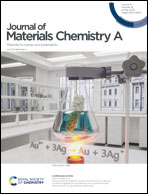In situ conversion of metal (Ni, Co or Fe) foams into metal sulfide (Ni3S2, Co9S8 or FeS) foams with surface grown N-doped carbon nanotube arrays as efficient superaerophobic electrocatalysts for overall water splitting†
Abstract
High-efficiency electrocatalysts at large current densities require consideration of not only the intrinsic activities but also the surface geometric structures. Here, we report a simple strategy to obtain metal sulfide (Ni3S2, Co9S8 and FeS) foams by in situ conversion of commercial Ni, Co and Fe foams through a conventional annealing reaction. Interestingly, N-doped carbon nanotubes, which are catalyzed by the corresponding metal sulfide nanocrystals, can also be obtained on the surface of the foams. The as formed Ni3S2 foams can work as bifunctional electrodes for overall water splitting with a potential of 1.5 V and 1.72 V at a current density of 10 mA cm−2 and 100 mA cm−2, respectively, which are comparable to the state-of-the-art transition-metal-sulfide-based bifunctional electrocatalysts reported to date. Factors such as abundant electrocatalytic active sites and excellent conductivity contribute to the gas evolution properties of nickel sulfide foams. Interestingly, the prominent performance of the nickel sulfide foams is also due to the nanotube array coating which provides special superaerophobic structures. The unique surface geometry provides little solid–gas contact area (solid content as low as 2%) at the electrode/bubble interface, and ultrasmall gas bubbles with diameters below 100 μm can leave the surface of the electrodes with ease, which effectively reduces the bubble overpotential and greatly promotes gas evolution properties especially at high current densities. Our research provides a facile strategy to obtain superaerophobic surface geometry for in situ prepared transition metal sulfide foams, which can work as bifunctional electrocatalysts for overall water splitting at large current densities. These findings may bring new insights in the design of efficient electrocatalysts for overall water splitting.



 Please wait while we load your content...
Please wait while we load your content...